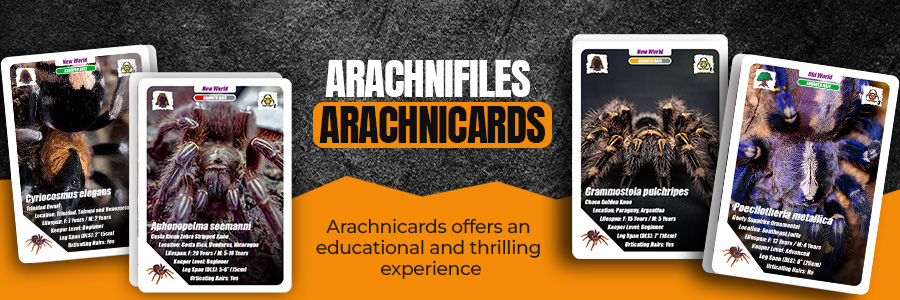Anatomy Of A Tarantula
Tarantulas are fascinating creatures that have captured the imagination of people for centuries. These eight-legged arachnids are known for their distinctive appearance and fascinating behavior, but did you know that there is a lot more to a tarantula than meets the eye? In this blog post, we will take a closer look at the anatomy of a tarantula and explore the various parts that make up this unique creature.
The Cephalothorax
The cephalothorax of a tarantula is a crucial part of its anatomy, encompassing both the head (cephalo-) and thorax (-thorax) regions. This distinctive body section holds a wealth of essential structures and plays a fundamental role in the tarantula’s overall functionality.
The head portion of the cephalothorax contains several notable features. Multiple pairs of eyes, typically eight, are situated on the front of the head. These eyes provide the tarantula with a wide field of vision, enabling it to detect movement and potential prey or threats in its surroundings. Alongside the eyes, the head also houses the tarantula’s chelicerae, which are modified appendages that bear the spider’s fangs. These fangs are used for capturing and immobilizing prey by injecting venom.
The thorax region of the cephalothorax holds appendages crucial for the tarantula’s locomotion and sensory perception. The tarantula’s eight legs, which are attached to the thorax, provide the spider with remarkable agility and coordination. These legs are equipped with specialized structures, such as bristles and spines, which aid in gripping, maneuvering, and detecting vibrations in the environment. Additionally, the thorax contains the pedipalps, which are elongated leg-like structures found near the mouthparts. The pedipalps serve various functions, such as sensing the environment, manipulating food, and in males, acting as reproductive organs.
The cephalothorax serves as the command center for the tarantula’s activities. It controls vital functions like movement, feeding, sensory perception, and reproduction. This intricate region, with its diverse array of sensory organs, locomotory appendages, and specialized mouthparts, allows the tarantula to navigate its surroundings, capture prey, communicate, and engage in other critical behaviors. The cephalothorax showcases the remarkable adaptability and efficiency of tarantulas, highlighting the intricate design and functionality of these fascinating arachnids.
The Abdomen
The abdomen of a tarantula is a vital and multifunctional part of its anatomy. Situated at the rear end of the spider’s body, the abdomen is a prominent feature that holds a wealth of essential components. It houses the tarantula’s internal organs, including the reproductive organs, digestive system, and silk glands.
The reproductive organs within the abdomen play a pivotal role in the tarantula’s life cycle. Female tarantulas have specialized structures for egg production and sperm storage, enabling them to reproduce. Males possess reproductive organs necessary for transferring sperm to the female during mating. The abdomen is where these crucial reproductive processes take place, ensuring the continuation of the species.
In addition to reproduction, the abdomen is home to the tarantula’s digestive system. This intricate system enables the spider to break down and process its prey. Once the tarantula captures its prey, it injects digestive enzymes into the captured animal, liquefying its internal tissues. The liquefied nutrients are then absorbed through the tarantula’s digestive system within the abdomen, providing sustenance and energy for the spider’s survival.
Silk glands, another remarkable feature of the tarantula’s abdomen, are responsible for producing the silk that the spider uses for various purposes. Tarantulas can spin silk to construct intricate webs for catching prey, create protective retreats, line their burrows, or produce silk threads for other specialized behaviors. The abdomen houses these silk glands, which produce silk proteins that are extruded through specialized spinnerets located on the underside of the tarantula’s abdomen.
The Legs
We can’t talk about tarantula anatomy without the amazing legs! The legs of a tarantula are marvels of adaptability and functionality, essential for its survival and daily activities. These remarkable arachnids have eight legs, each with unique structures and capabilities that contribute to their overall locomotion, hunting, and sensory perception.
Tarantula legs are equipped with specialized features that enable them to navigate various terrains with agility and precision. Each leg consists of multiple segments, connected by flexible joints, allowing for a wide range of movement and flexibility. The tarantula’s legs are covered in microscopic hairs, known as setae, which aid in sensory perception and provide tactile feedback. These setae can detect vibrations, temperature changes, and even chemical cues in the environment.
The tarantula’s legs play a crucial role in capturing and subduing prey. Equipped with sharp claws at the end of each leg, tarantulas can effectively grasp and immobilize their victims. The legs also bear small, comb-like structures called tarsi, which help in manipulating and controlling their prey during feeding.
Furthermore, tarantula legs contribute to their unique hunting techniques. Some species employ a sit-and-wait strategy, relying on their exceptional vision and sensitivity to vibrations to detect approaching prey. Once a potential meal is within reach, tarantulas swiftly extend their legs to capture and secure the prey, delivering venomous bites with their formidable fangs.
The legs of a tarantula are not only instrumental in movement and hunting but also in communication. When threatened or alarmed, tarantulas may raise their front legs in a defensive posture, warning potential predators or intruders to keep their distance.
The Pedipalps
The pedipalps of a tarantula are fascinating appendages located near the mouthparts, making them an integral part of the spider’s anatomy. These specialized structures serve multiple essential functions, contributing to the tarantula’s sensory perception, feeding, and reproductive processes.
The primary role of the pedipalps is sensory in nature. Equipped with fine setae, the pedipalps allow tarantulas to explore their surroundings and gather valuable information about their environment. These sensory hairs provide the spider with tactile feedback, allowing it to detect vibrations, temperature changes, and chemical cues. The pedipalps are particularly sensitive, aiding the tarantula in locating potential prey, mates, and even assessing potential threats or predators.
In addition to sensory perception, the pedipalps also play a critical role in the tarantula’s feeding process. These appendages are modified into elaborate mouthparts that assist in handling and manipulating prey. Tarantulas utilize their pedipalps to capture and hold their victims, securing them while the spider delivers venomous bites with its fangs. The pedipalps also aid in the initial breakdown of prey, assisting the tarantula in tearing and shredding the captured food into more manageable pieces.
Moreover, the pedipalps are of great significance in the reproductive processes of tarantulas. In male tarantulas, the pedipalps undergo a specialized modification known as the embolus. The embolus functions as a specialized reproductive organ that transfers sperm to the female during mating. These structures are essential for successful reproduction, ensuring the continuity of the tarantula species.
The Spinnerets
Spinnerets are remarkable structures found on the underside of a tarantula’s abdomen, and they are responsible for producing and manipulating silk. These specialized appendages play a crucial role in the tarantula’s ability to spin silk threads, which have a multitude of uses in the spider’s life.
Tarantulas have several pairs of spinnerets, typically ranging from two to four. Each spinneret consists of numerous microscopic spigots, through which the silk proteins are extruded. These proteins combine and solidify upon contact with the air, forming the versatile substance we know as spider silk.
The silk produced by tarantulas serves various purposes. One of the most well-known uses is web-building. Different tarantula species construct a variety of web types, ranging from intricate orb webs to simple sheet-like structures. These webs serve as a means of capturing prey, providing a secure retreat, and even facilitating mating behaviors. Tarantulas carefully manipulate their spinnerets to create the precise pattern and structure of their webs.
Spinnerets are not solely limited to web construction. Tarantulas also utilize silk for other important functions. They may create draglines, which are sturdy silk strands that allow them to move safely across different surfaces, including vertical and inverted ones. Silk is also used for lining burrows, reinforcing egg sacs, and constructing silk mats for molting.
The ability to produce silk and manipulate it through spinnerets is a remarkable adaptation that underscores the versatility of tarantulas. The silk they create is strong, flexible, and crucial for their survival and reproductive success. The spinnerets are a testament to the intricacies of spider biology and their exceptional ability to create and utilize this incredible material.
Urticating Hairs
Urticating hairs are a fascinating defense mechanism employed by certain species of tarantulas. These specialized hairs are found on the abdomen of the spider and serve as a formidable deterrent against potential threats or predators.
Urticating hairs are different from the regular setae found on the tarantula’s body. They are barbed, bristle-like structures that are easily dislodged when the tarantula feels threatened. Once released, these hairs can cause irritation, discomfort, and even injury to the eyes, skin, or respiratory system of the predator.
When confronted by a potential threat, a tarantula will often use its hind legs to brush its abdomen, dislodging a cloud of urticating hairs. The hairs are then launched toward the perceived threat, creating a defense mechanism that allows the tarantula to escape or discourage the predator.
There are different types of urticating hairs, varying in size, shape, and potency. Some species have hairs that are more irritating and cause more severe reactions than others. The effects of these hairs can range from mild itching and irritation to severe inflammation and allergic reactions in susceptible individuals.
Urticating hairs provide tarantulas with a non-contact defense mechanism, allowing them to protect themselves without engaging in a direct physical confrontation. This adaptation is particularly useful for ground-dwelling tarantulas that may encounter a variety of predators in their natural habitats.
Conclusion
In conclusion, the anatomy of a tarantula is a complex and fascinating subject. From the cephalothorax to the spinnerets, each part of a tarantula plays an important role in its survival and behavior. The next time you encounter one of these eight-legged creatures, take a moment to appreciate the intricate design and function of each part.
Other Helpful Info!
If you found this post helpful, please consider sharing it. It really helps the site in the search algorithm! Thanks!
Do you have inverts and arachnids? Want a fun way of tracking them? Then download Arachnifiles for Android or iOS today! It’s free!
Want to read more helpful blog posts? Click here to view other blog posts!
Want to read more about invertebrate care? Click here to view other care guides!




